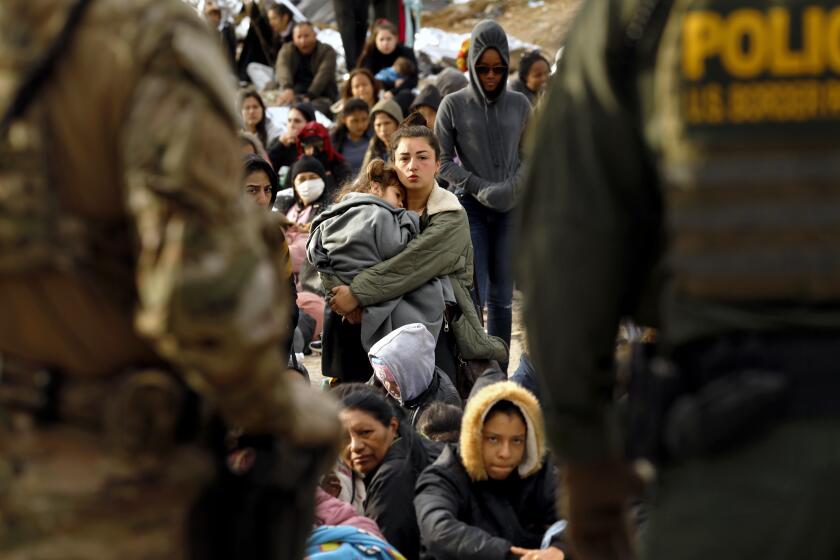Ruling Could Free Hundreds of Immigrants
In a defeat for the Bush administration, the Supreme Court ruled Wednesday that the government may not indefinitely imprison immigrants who cannot be deported, even if they are in the country illegally.
The high court’s 7-2 ruling means that about 920 immigrants, most of them Cubans, may be eligible to be released, according to the Homeland Security Department’s Immigration and Customs Enforcement agency.
The detainees in question entered the country illegally, 747 of them as part of the 1980 Mariel boatlift from Cuba.
Most of the 747 committed crimes and completed prison sentences, yet remain in custody because attempts to deport them to Cuba have been blocked by Cuba’s refusal to take them back.
In 2001, the Supreme Court limited how long a legal immigrant could be detained to a reasonable period of time, usually six months, if deportation was not foreseeable. Wednesday’s ruling expanded that ruling to illegal immigrants.
Civil liberties and human rights advocates applauded the latest ruling.
“It adds to the growing list of Supreme Court rulings affirming the rights of noncitizens and overturning the Bush administration’s overreaching claims,” said Lucas Guttentag, director of the ACLU Immigrants’ Rights Project, whose organization filed written arguments in court. “It points to the crucial role of judicial oversight over executive decisions.”
But some groups that advocate restrictive immigration policies warned that the detainees’ release could pose a threat.
“We would hope that illegal aliens will not be released under this decision if they represent a threat to the society,” said Jack Martin, special projects director for the Federation for American Immigration Reform, which favors reduced immigration.
In making its case, the federal government argued that releasing the immigrants “would create an unprotected spot in this country’s defense of its borders, and this, in turn, would undoubtedly subject the residents of this nation to greater security risks.”
But lawyers for one of the immigrants countered that it was “not only unpalatable but also untenable” to conclude that the people living in the United States, either voluntarily or not, could be subjected to life in prison simply because their country of origin would not have them back, like the Cubans from the Mariel boatlift.
In 1980, large numbers of Cubans began sailing to the United States in a boatlift from the port of Mariel near Havana. In all, about 125,000 arrived, a small percentage of whom were considered criminals.
Most of the 125,000 were allowed to remain in the country legally.
Until 1996, federal law permitted Cubans who were paroled into the United States to become lawful permanent residents after one year.
But the immigrants named in the two cases decided Wednesday, Sergio Suarez Martinez and Daniel Benitez, were ineligible because of a variety of criminal convictions. Both had served their sentences and were being held in immigration custody when they challenged their detentions.
In Martinez’s case, a U.S. District Court judge in Oregon had ordered the government to release him, and the 9th U.S. Circuit Court of Appeals in California had upheld the ruling.
In Benitez’s case, a U.S. District Court judge in Florida had denied his petition for release and an appeals court had upheld that decision.
On Wednesday, Manny Van Pelt, spokesman for the Immigration and Customs Enforcement agency, said it was too early to say what would happen to the 920 being held.
“We’re confident that we’ll be able to continue our mission of restoring integrity to the nation’s immigration system while complying with the high court’s ruling,” he said.
Most of the detainees are behind bars on the East Coast, Van Pelt said. Many are at Krome Detention Center near Miami; others are at York County Prison in Pennsylvania, Passaic County Jail in New Jersey and Hudson County Jail in New York, Van Pelt said.
They have been held for varying amounts of time. Some, who were determined to have been criminals in Cuba, have never been released into society in the United States. Others may have been barred because they had no visa or passport, were drug addicts or communists, or were afflicted with contagious diseases, Van Pelt said.
Van Pelt was unable to say what other nationalities were represented among the detainees.
Beginning in 2001, the government assessed immigrants’ cases individually, and those who did not appear to pose a threat were released to halfway houses, community groups or family members.
Their deportation orders are still valid, and the government has a program to keep track of them in case it becomes possible to deport them, Van Pelt said.
Martin said the detainees presented a “potential threat,” and he urged the government to be cautious in releasing them.
But Nadine Wettstein, a lawyer for the American Immigration Law Foundation, which promotes less restrictive immigration policies, said that the detainees did not as a rule represent a threat to society.
“If they commit another offense, they can be rearrested just like anyone else,” she added. “But in this country we don’t lock people up for the rest of their lives just because we can’t deport them. That’s what the court said.”
More to Read
Start your day right
Sign up for Essential California for news, features and recommendations from the L.A. Times and beyond in your inbox six days a week.
You may occasionally receive promotional content from the Los Angeles Times.






